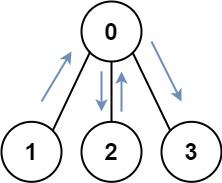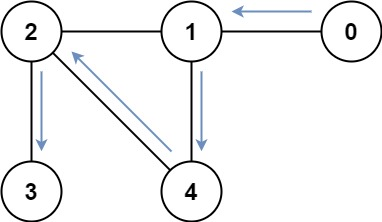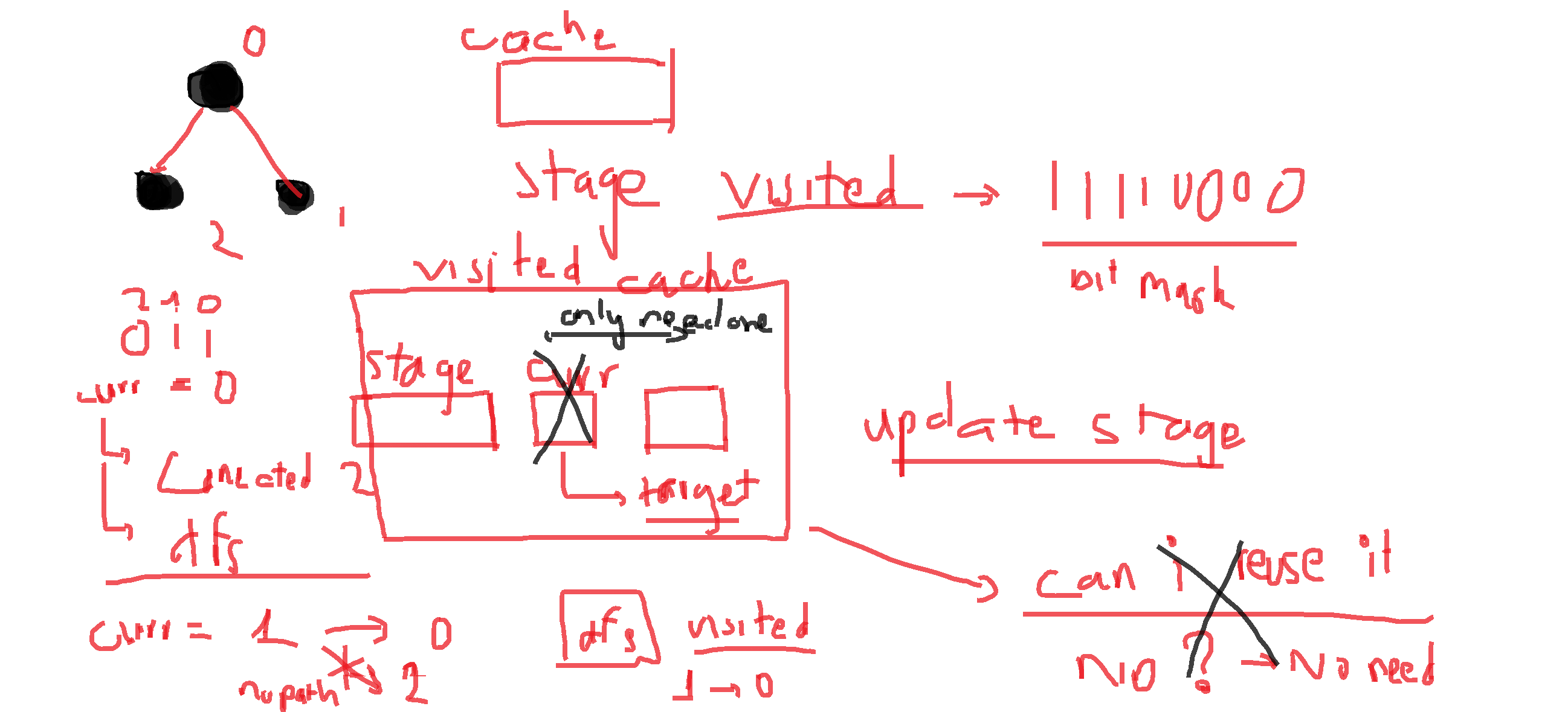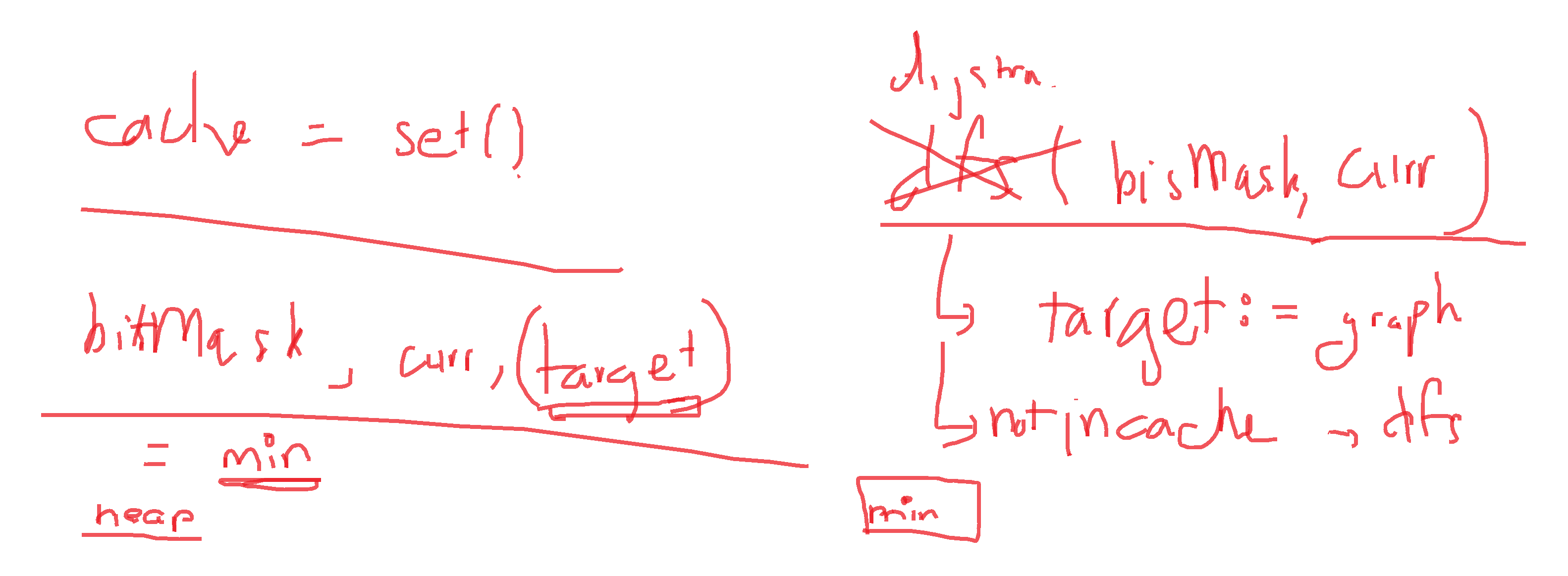847. Shortest Path Visiting All Nodes
Problem¶
You have an undirected, connected graph of n nodes labeled from 0 to n - 1. You are given an array graph where graph[i] is a list of all the nodes connected with node i by an edge.
Return the length of the shortest path that visits every node. You may start and stop at any node, you may revisit nodes multiple times, and you may reuse edges.
Example 1:
Input: graph = [[1,2,3],[0],[0],[0|1,2,3],[0],[0],[0]]
Output: 4
Explanation: One possible path is [1,0,2,0,3]
Example 2:
Input: graph = [[1],[0,2,4],[1,3,4],[2],[1,2|1],[0,2,4],[1,3,4],[2],[1,2]]
Output: 4
Explanation: One possible path is [0,1,4,2,3]
Constraints:
n == graph.length1 <= n <= 120 <= graph[i].length < ngraph[i]does not containi.- If
graph[a]containsb, thengraph[b]containsa. - The input graph is always connected.
Solve¶
White board¶
My white board be like
Need to work more before start coding
- Frist I try to use a cache, to find anything that we can store into memory, that needed to solve the problem
- I quickly thought about storing the stage of current problem, we are given:
- Current
currstart point (I assuming it need to be node0for started node, the problem said we can chose any for start node, RTFM moments) - A list of Node in graph that need to be visited
- Current
- For the purpose
- I try saving a
targetnext point that we are try to go to next - This is base on that, a stage can be un-change, we need to go to the next point so that we can go to the next point (huh?) that can update the stage.
- Example, when we start at
[0] -> [1], we need to go back to[0]before getting back to[2](result path[0] -> [1] -> [0] -> [2])
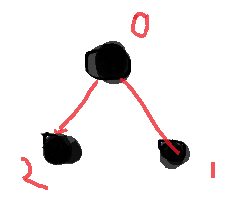
- This make me think that I want to save the stage of this kind of updated interaction (so I not repeating it again)
- So, we have 3 parameters, cache contain the value of the total step that get to that stage:
stage = [0], start = 0, target = 1 -> step = 1
stage = [0, 1], start = 1, target = 0 -> step = 2
stage = [0, 1], start = 0, target = 2 -> step = 3
- I try saving a
- This is good enough:
- A cache that storing all possible finite update
- The value that cache store being update every step that telling us how much step needed to reach that stage
- We can stop the updating if stage contain all the node
- I quickly thought about storing the stage of current problem, we are given:
- By roughly though of the Algorithm, I think of this:
- A Dijkstra -like:
- Chose the lowest step in cache
- Update all possible next stage it can reach to
- This require us to keep trach an not repeat processing old stage
- Data structure - Heap:
- So we can easily find the min value in O(1)
- A Dijkstra -like:
Dijkstra + Heap, cache on every update¶
dynamic_programing
First implement - Separated start node run¶
My first implement
- I try every started node in a separated run
- This result into a nested n loop, updating a possible
cachesize of(n ** 2 * 2 ** n). Making it a worst possibleO(n ** 3 * 2 ** n)time complexity (n just too small so I just skiplog ntime to push and pop heap, maybe it wrong though)
class Solution:
def shortestPathLength(self, graph: List[List[int]]) -> int:
n = len(graph)
MAXSTAGE = (1<<(n))-1
def tryStartAt(index):
cache = [[[-1] * n for i in range(n)] for _ in range(MAXSTAGE+1)]
shortest = -1
heap = []
def setbit(mask, pos):
return mask | (1 << (pos))
heap.append((0,(setbit(0, index),index)))
while len(heap) > 0:
acumulated, (stage, start) = heappop(heap)
if stage == MAXSTAGE:
shortest = acumulated
break
for target in graph[start]:
if cache[setbit(stage, target)][start][target] == -1:
nextStage = setbit(stage, target)
cache[nextStage][start][target] = acumulated + 1
heappush(heap, (acumulated + 1, (nextStage, target)))
return shortest
minimum = -1
for i in range(n):
curr = tryStartAt(i)
if minimum == -1 or minimum > curr:
minimum = curr
return minimum
Optimizing 1 - All node at started¶
O(n ** 2 * 2 ** n)
Instead of using a separated run, we can adding all started node directly into the cache, this mean we can use any other started stage to optimize the cache matrix
- This thus reduce the nested loop, we only need to update
cachetable with possible sizen ** 2 * 2 ** n - Worst case will be
O(n ** 2 * 2 ** n)(again, I skiplog ntime using on heap push, pop as n is very small)
class Solution:
def shortestPathLength(self, graph: List[List[int]]) -> int:
n = len(graph)
MAXSTAGE = (1<<(n))-1
cache = [[[-1] * n for i in range(n)] for _ in range(MAXSTAGE+1)]
shortest = -1
heap = []
def setbit(mask, pos):
return mask | (1 << (pos))
for index in range(n):
heap.append((0,(setbit(0, index),index)))
while len(heap) > 0:
acumulated, (stage, start) = heappop(heap)
if stage == MAXSTAGE:
shortest = acumulated
break
for target in graph[start]:
if cache[setbit(stage, target)][start][target] == -1:
nextStage = setbit(stage, target)
cache[nextStage][start][target] = acumulated + 1
heappush(heap, (acumulated + 1, (nextStage, target)))
return shortest
Optimizing 2 - Less cache stage¶
O(n * 2 ** n)
A
Visited Stage, start -> targetstage making us repeat processing to get to a same (Visited Stage, Current node).
We not need to save start node in cache at all, this is because that we always have the minimum possible step using heap, making every update is the best possible total path step to reach (Visited Stage, Current node).
This mean we can drop [start] from cache, reducing possible cache size to n * 2 ** n. Reduce possible worst time complexity to O(n * 2 ** n) (again, I skip log n time using on heap push, pop)
class Solution:
def shortestPathLength(self, graph: List[List[int]]) -> int:
n = len(graph)
MAXSTAGE = (1<<(n))-1
visited = set()
shortest = -1
queue = deque()
def setbit(mask, pos):
return mask | (1 << (pos))
for index in range(n):
queue.append((0,(setbit(0, index),index)))
while len(queue) > 0:
acumulated, (stage, start) = queue.popleft()
if stage == MAXSTAGE:
shortest = acumulated
break
for target in graph[start]:
if (setbit(stage, target), target) not in visited:
nextStage = setbit(stage, target)
visited.add((setbit(stage, target), target))
queue.append((acumulated + 1, (nextStage, target)))
return shortest
Biggest realization - BFS + Queue¶
BFS
- As we always have the best accumulated on every step. This make heap isn’t necessary, and can be transfer into a First in, First out Queue data structure
- Also, the Dijkstra not necessary to contain the accumulated, every visited have the best possible value (a BFS traversal on possible stage graph)
Now this, make it a true O(n * 2 ** n) solution
class Solution:
def shortestPathLength(self, graph: List[List[int]]) -> int:
n = len(graph)
MAXSTAGE = (1<<(n))-1
visited = set()
shortest = -1
queue = deque()
def setbit(mask, pos):
return mask | (1 << (pos))
for index in range(n):
queue.append((0,(setbit(0, index),index)))
while len(queue) > 0:
acumulated, (stage, start) = queue.popleft()
if stage == MAXSTAGE:
shortest = acumulated
break
for target in graph[start]:
if (setbit(stage, target), target) not in visited:
nextStage = setbit(stage, target)
visited.add((setbit(stage, target), target))
queue.append((acumulated + 1, (nextStage, target)))
return shortest
Created : September 17, 2023
